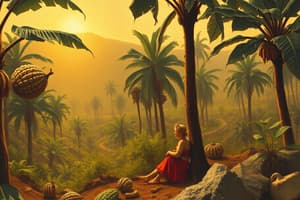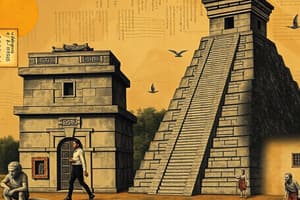Podcast
Questions and Answers
Quipu is a system of knotted ropes used by the Inca civilization to keep records that only experts can interpret, equating to ______ codes or signals in modern times.
Quipu is a system of knotted ropes used by the Inca civilization to keep records that only experts can interpret, equating to ______ codes or signals in modern times.
secret
The Aztec civilization introduced chocolates, known as cacao, which was used as ______ and even as a tribute to gods.
The Aztec civilization introduced chocolates, known as cacao, which was used as ______ and even as a tribute to gods.
currency
Antispasmodic medication used by ancient civilizations like the Aztecs included the passion flower to prevent muscle spasms and relax muscles, aiding in ______.
Antispasmodic medication used by ancient civilizations like the Aztecs included the passion flower to prevent muscle spasms and relax muscles, aiding in ______.
surgery
Chinampas were rectangular agricultural areas surrounded by canals, associated with the ______ civilization.
Chinampas were rectangular agricultural areas surrounded by canals, associated with the ______ civilization.
The Olmec civilization is known for its monumental sacred complexes, massive stone sculptures, ball games, the drinking of chocolate, and the representation of the Animal god, Seated Figure, and Bird-Shaped ______.
The Olmec civilization is known for its monumental sacred complexes, massive stone sculptures, ball games, the drinking of chocolate, and the representation of the Animal god, Seated Figure, and Bird-Shaped ______.
India is known for its contributions to the development of knowledge, particularly in the field of Iron and ______ works.
India is known for its contributions to the development of knowledge, particularly in the field of Iron and ______ works.
In the early Philippine scientific development, the first inhabitants arrived by a land bridge in Palawan & Batangas around __________ years ago.
In the early Philippine scientific development, the first inhabitants arrived by a land bridge in Palawan & Batangas around __________ years ago.
The 'Dawnmen' (or 'cavemen') and 'Aetas' or 'Negritoes' were the early inhabitants known to use simple tools & weapons made of __________.
The 'Dawnmen' (or 'cavemen') and 'Aetas' or 'Negritoes' were the early inhabitants known to use simple tools & weapons made of __________.
The Spanish arrival in the Philippines in ________ found a primitive level of technological development.
The Spanish arrival in the Philippines in ________ found a primitive level of technological development.
During early Philippine engagement in science, they had knowledge of the curative values of plants, including medicine extraction from __________.
During early Philippine engagement in science, they had knowledge of the curative values of plants, including medicine extraction from __________.
The early Filipinos had an alphabet, a system of writing, a method of counting, weights, and measures, but no __________.
The early Filipinos had an alphabet, a system of writing, a method of counting, weights, and measures, but no __________.
The Manila Galleon trade caused neglect of agriculture & mining, as well as the decline of native handicrafts/industries, with the exception of __________ which was entirely done by Filipinos.
The Manila Galleon trade caused neglect of agriculture & mining, as well as the decline of native handicrafts/industries, with the exception of __________ which was entirely done by Filipinos.
One of the regions of the world where the agricultural revolution arose independently great civilizations of Mesoamerica were built upon foods such as maize, beans, and ______.
One of the regions of the world where the agricultural revolution arose independently great civilizations of Mesoamerica were built upon foods such as maize, beans, and ______.
Prior to European colonization, Mezoamerica had a rich ______.
Prior to European colonization, Mezoamerica had a rich ______.
The Mayan civilization was known to be good in ______.
The Mayan civilization was known to be good in ______.
The Mayans developed the concept of ______.
The Mayans developed the concept of ______.
In Inca civilization, communication was accomplished by runners known as ______.
In Inca civilization, communication was accomplished by runners known as ______.
The Inca civilization built earthquake-resilient stone ______.
The Inca civilization built earthquake-resilient stone ______.
Flashcards are hidden until you start studying
Study Notes
Mesoamerica
- Comprises modern-day countries of northern Costa Rica, Nicaragua, Honduras, El Salvador, Guatemala, Belize, and central to southern Mexico.
- One of the regions where the agricultural revolution arose independently.
- Great civilizations were built upon foods like maize, beans, and squash.
- Rich culture prior to European colonization.
Maya Civilization
- Lasted for 2,000 years.
- Known for:
- Good in astronomy, using temples for astronomical observation.
- Technology to grow crops and build elaborate cities with hydraulics systems.
- Looms for weaving and other work of arts.
- Producing rubber.
- Hieroglyphics (sacred writing) and development of the concept of zero.
- Worshiping more than 150 Gods.
- The Mayan Numerical System is vigesimal (based on 20).
- The Mayan Writing System uses hieroglyphics.
Inca Civilization
- Roads were paved with stone and were earthquake resilient.
- Communication was accomplished by runners on the roads (fast young men called "chaskis").
- Quipu - a system of knotted ropes to keep records, similar to secret codes or signals in modern times.
- Textiles were regarded for artistic achievements.
Aztec Civilization
- Introduced mandatory education.
- Introduced chocolates (Theobroma "food of the gods").
- Used cacao as currency and as a tribute to gods.
- Developed antispasmodic medication using the passion flower.
- Chinampa - rectangular agricultural areas surrounded by canals.
Olmec Civilization
- Name means "rubber people" (ōlli meaning "natural rubber" and mēcatl meaning "people").
- Known for:
- Monumental sacred complexes.
- Massive stone sculptures.
- Ball games.
- The drinking of chocolate.
- Animal god Seated Figure Bird-Shaped Vessel.
Development of Science in Asia
- Civilizations in Asia made significant contributions to the development of knowledge.
Roots of Early Philippine Scientific Development
- First inhabitants arrived in the Philippines 50,000 years ago via a land bridge in Palawan and Batangas.
- Early inhabitants were known as "Dawnmen" (or "cavemen") and "Aetas" or "Negritoes".
- In the next 40,000 years, simple tools and weapons were developed, eventually using metal smelting.
- In 1521, Spanish arrived in the Philippines and found simple levels of technological development.
- Engagement in science was basically primitive, with knowledge of curative values of plants and medicine extraction from herbs.
- They had an alphabet, a system of writing, a method of counting, weights, and measure.
- No calendar, counted years by the moon, and from one harvest to another.
- Development of schools (Colegio de San Ildefonso in Cebu and Colegio de San Ignacio in Manila), the first educational institutions in Asia by Europeans.
- Development of hospitals and orphanages.
- Manila Galleon trade (Spanish trading ships) caused neglect of agriculture and mining, as well as the decline of native handicrafts/industries.
- Only shipbuilding was entirely by Filipinos, showcasing excellent work and abstruse science and math capability.
Studying That Suits You
Use AI to generate personalized quizzes and flashcards to suit your learning preferences.




